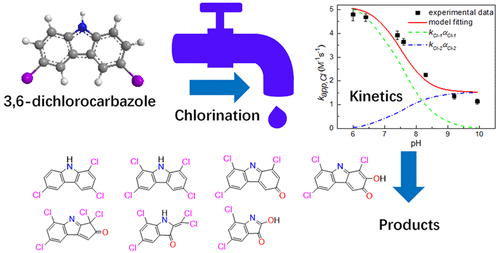当前位置:
X-MOL 学术
›
ACS ES&T Water
›
论文详情
Our official English website, www.x-mol.net, welcomes your feedback! (Note: you will need to create a separate account there.)
Fate of New Persistent Organic Chemical 3,6-Dichlorocarbazole in Chlorinated Drinking Water
ACS ES&T Water Pub Date : 2021-07-22 , DOI: 10.1021/acsestwater.1c00077 Guowei Wang 1, 2 , Kefu Ye 1, 3 , Shixiang Gao 4 , Huijie Hou 1, 3 , Bingchuan Liu 1, 3 , Keke Xiao 1, 3 , Jingping Hu 1, 3 , Sha Liang 1, 3 , Jiakuan Yang 1, 3, 5
ACS ES&T Water Pub Date : 2021-07-22 , DOI: 10.1021/acsestwater.1c00077 Guowei Wang 1, 2 , Kefu Ye 1, 3 , Shixiang Gao 4 , Huijie Hou 1, 3 , Bingchuan Liu 1, 3 , Keke Xiao 1, 3 , Jingping Hu 1, 3 , Sha Liang 1, 3 , Jiakuan Yang 1, 3, 5
Affiliation

|
Polyhalogenated carbazoles (PHCZs) make up a group of persistent, bioaccumulative, and toxic contaminants and are newly identified as chlorinated disinfection byproducts. However, the fates of these compounds in prolonged chlorination are largely unknown, leading to a great threat to the safety of drinking water. This study investigated the transformation of PHCZs during prolonged chlorination by using 3,6-dichlorocarbazole (36-CCZ) as a model congener, providing important information about the fates of PHCZs in drinking water. The degradation kinetics of 36-CCZ showed a strong pH dependency with apparent second-order rate constants of 1.52–5.17 M–1 s–1 at pH 6–10. The degradation rates are comparable to that of pyrene in chlorination. Seven new chlorine-containing products P1–P7 were detected. Transformation pathways, involving electrophilic chlorination, nucleophilic water addition, aromatic ring opening, and HCl elimination, were proposed, and the reaction mechanism was explored. The product evolution versus time showed the first generation of the highly halogenated carbazoles of 1,3,6-trichlorocarbazole (P1) and 1,3,6,8-tetrachlorocarbazole (P2), followed by the generation of hydroxylated products P3–P7. The persistence of the seven products in chlorinated water over 24 h indicated that human exposure to PHCZs and/or their transformation products was highly possible. This study provides novel insights into the behaviors of PHCZs in drinking water.
中文翻译:

新型持久性有机化学品 3,6-二氯咔唑在氯化饮用水中的命运
多卤化咔唑 (PHCZ) 是一组具有持久性、生物累积性和毒性的污染物,最近被确定为氯化消毒副产品。然而,这些化合物在长时间氯化中的去向在很大程度上是未知的,这对饮用水的安全造成了极大的威胁。本研究使用 3,6-二氯咔唑 (36-CCZ) 作为模型同系物研究了长时间氯化过程中 PHCZs 的转化,提供了关于 PHCZs 在饮用水中的归宿的重要信息。36-CCZ 的降解动力学表现出强烈的 pH 依赖性,在 pH 6-10下,明显的二级速率常数为 1.52-5.17 M –1 s –1。降解速率与氯化中芘的降解速率相当。七款含氯新产品检测到P1-P7。提出了亲电氯化、亲核加水、芳环开环和HCl消除等转化途径,并探讨了反应机理。产物随时间的演变显示第一代高度卤化咔唑 1,3,6-三氯咔唑 ( P1 ) 和 1,3,6,8-四氯咔唑( P2 ),随后生成羟基化产物P3-P7。7 种产物在氯化水中的持久性超过 24 小时表明人类极有可能接触 PHCZ 和/或其转化产物。这项研究为 PHCZs 在饮用水中的行为提供了新的见解。
更新日期:2021-08-13
中文翻译:

新型持久性有机化学品 3,6-二氯咔唑在氯化饮用水中的命运
多卤化咔唑 (PHCZ) 是一组具有持久性、生物累积性和毒性的污染物,最近被确定为氯化消毒副产品。然而,这些化合物在长时间氯化中的去向在很大程度上是未知的,这对饮用水的安全造成了极大的威胁。本研究使用 3,6-二氯咔唑 (36-CCZ) 作为模型同系物研究了长时间氯化过程中 PHCZs 的转化,提供了关于 PHCZs 在饮用水中的归宿的重要信息。36-CCZ 的降解动力学表现出强烈的 pH 依赖性,在 pH 6-10下,明显的二级速率常数为 1.52-5.17 M –1 s –1。降解速率与氯化中芘的降解速率相当。七款含氯新产品检测到P1-P7。提出了亲电氯化、亲核加水、芳环开环和HCl消除等转化途径,并探讨了反应机理。产物随时间的演变显示第一代高度卤化咔唑 1,3,6-三氯咔唑 ( P1 ) 和 1,3,6,8-四氯咔唑( P2 ),随后生成羟基化产物P3-P7。7 种产物在氯化水中的持久性超过 24 小时表明人类极有可能接触 PHCZ 和/或其转化产物。这项研究为 PHCZs 在饮用水中的行为提供了新的见解。



























 京公网安备 11010802027423号
京公网安备 11010802027423号